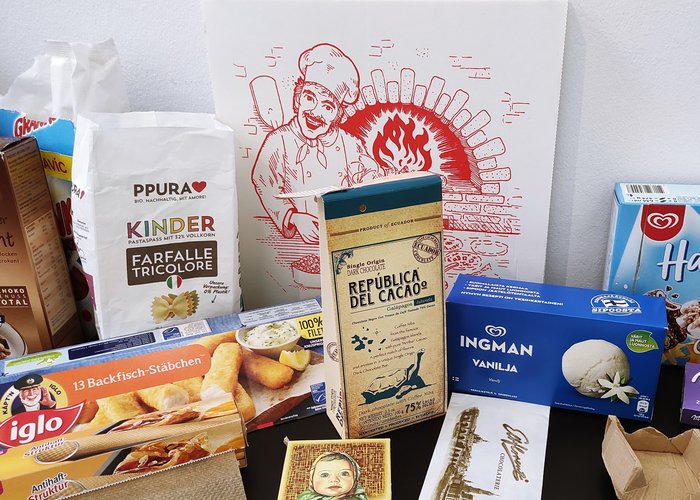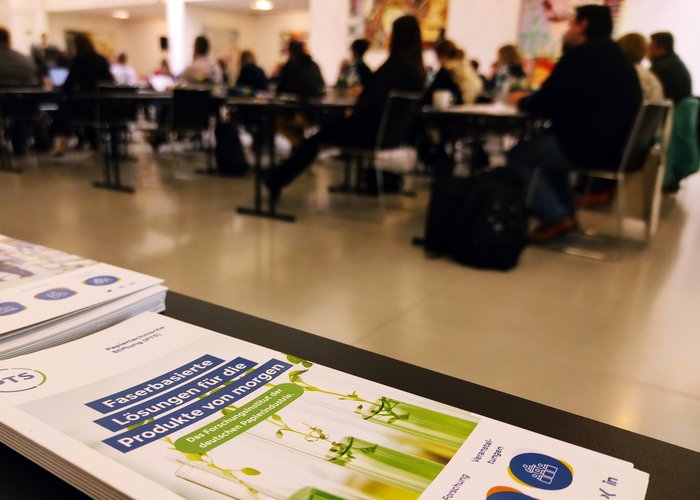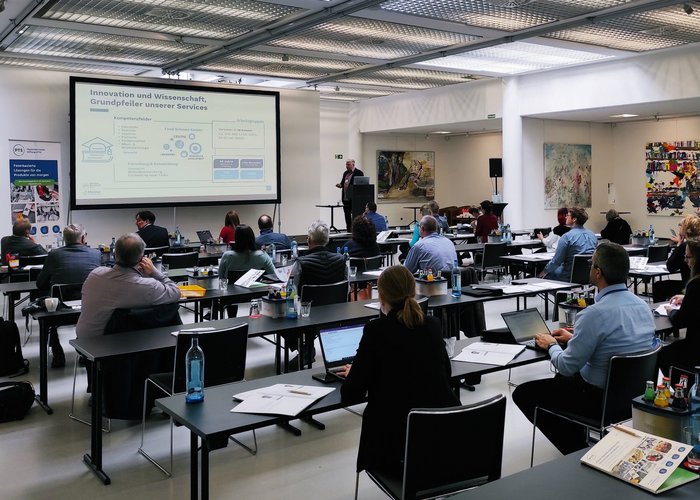PTS Technical Meeting “Paper, board and tissue in food contact“ in March 2023 – highlights
Recent developments in the folding box sector, Christian Schiffers – Association of the Folding Box Industry (FFI)
In the beginning, Mr. Schiffers provided a comprehensive overview of the current trends in the folding box sector in Germany and Europe. He made it very clear that the regulatory endeavours of the European Green Deal were about to cause a “regulatory tsunami” coming towards packaging manufacturers: EU climate law, chemicals strategy, corporate sustainability reporting, farm-to-fork strategy, and the EU plastics strategy arising from the Single-Use Plastics Directive (SUPD) and its implementation in national law, to mention just a few. He presented in detail the Packaging and Packaging Waste Regulation (PPWR). Furthermore, he outlined in a keyword style the challenges arising from the European regulatory activities in terms of printing inks, perfluorated chemicals (PFAS), mineral oil, endocrine disruptors, and the revision timeline for the Regulation 1935/2004.
Chemicals strategy for sustainability – an impact analysis,Dr. Sabine Lindner – PlasticsEurope Deutschland e.V.
The European Green Deal was explained by Dr. Lindner under the aspect of the new chemicals strategy of the EU. At present, a comprehensive knowledge base for the identification and assessment of the chemicals does not exist.
Therefore, this knowledge base must be established and compiled in a cooperation between authorities, such as ECHA and EFSA, and industries. She outlined the opportunities and questions arising from the “One substance – one assessment” (OSOA) approach that is envisaged to be used for the coordination of the collection and assessment of data and for the subsequent regulatory implementation. She criticised the introduction of the “mixture assessment factor” (MAF) as an additional allocation factor meant to account for combination effects of substances in mixtures because of the potential overlap with already existing allocation factors.
SUPD | single-use plastics legislation and impact of the PPWR, Thorsten Plutta – PRO-S-PACK collaborative association for service packaging
A currently much debated goal of the EU is to ban or at least reduce single-use products made of plastics. Therefore, Thorsten Plutta placed the focus on the SUPD and its implementation in national law, and on the impacts this has on paper products. He pointed out that the newly created German Single-Use Plastics Fund (EWKFond) encompasses all packaging products placed on the market including e.g. in-house packaging in system catering and in the medical area where the packaging will not typically leave the establishment. Furthermore, there are already attempts on the municipal level to extend the levies to be paid into the SUP fund to all and any packaging regardless of the material. With regard to the PPWR, he criticised that recent studies had already shown that multiple-use obligations would produce negative ecological effects and that risks related to food safety were not taken into account.
BPA – EFSA Draft for re-evaluation and criticism by BfR, Dr. Claudia Lorenz – Federal Institute for Risk Assessment (BfR) – Safety of food contact materials
Dr. Lorenz presented the position of her institute and significant points of criticism on the re-evaluation of BPA by EFSA. Her statements were brisk and cutting edge because she made them accessible to the audience before official publication of the divergence paper by BfR and EFSA. She referred to several points on which BfR and EFSA were not able to achieve a scientific and methodological consensus. From the BfR’s perspective, there are both older and recent studies having a higher scientific quality than those considered by EFSA. They lead to significantly different results. Nota bene: The divergence papers and a BfR risk assessment of BPA are meanwhile freely accessible over the Internet (cf. page 17 of PTS News, BPA article by E. Mehlhorn).
Bisphenol A – Analytical challenges and opportunities with the introduction of the new TDI, Jörg Konetzki – Institute Kirchhoff Berlin GmbH
After a short introduction to possible health hazards from PBA, to the EFSA Draft for re-evaluation, and to the safety requirements on food contact materials arising from Regulation 1935/2004, Mr. Konetzki went on to address the challenges regarding the analytical determination of the extremely lower tolerable daily intake (TDI) value of BPA. A very big problem is the elimination or reduction of BPA in blank values. Sample preparation should therefore be kept as simple as possible. For the analytical separation by means of HPLC, an additional trap column would be needed to retain BPA from the HPLC system for so long as is necessary to ensure that the latter arrives at the MS/MS detector after the BPA from the sample. This would allow limits of determination of 25 ng/kg of material via extraction and 1 ng/dm² of material for migration testing with Tenax®.
Organoleptic analyses (optical brighteners / sensory analysis) – problems and solutions, Prof. Dr. Thomas J. Simat – TU Dresden
Equipped with the popular Sniffin’ sticks, professor Simat began his presentation with an introduction to the world of organoleptic testing. He compared the DIN 10955 and DIN EN 1230-1/-2 standards and described their scopes of application in organoleptic tests.
In the second part of his presentation, he covered the empiric analysis of optical brightening agents (OBA). The test is based on a visual assessment of fluorescence intensity under UV light in comparison with a reference scale. However, the sulfonated stilbene derivatives frequently used as optical brighteners present an isomerism equilibrium, and only the trans-form is fluorescing. That is why the fluorescence intensity decreases significantly over time as a function of the matrix. This fact is not taken into account by the current standard. A way how to identify and quantify the various stilbene derivatives is not given either.
PFAS – Sample preparation, sum parameter method, and single substance analysis – challenges and solution approaches, Axel Ulbricht – Eurofins Umwelt Ost GmbH
The worldwide efforts to restrict the use of “forever chemicals”, as per and polyfluorated alkyl substances (PFAS) are generally called, are directly linked to the question how to analyse them. Against this background, Mr. Ulbricht presented the various approaches depending on whether the objective is to analyse PFAS single substances or sum parameters such as Total Organic Fluorine (TOF). He outlined methodological workflows of the various determination procedures, their applicability to certain matrices, and what their respective benefits or drawbacks are.
Current developments in German and European FCM legislation, Saskia Both – State Office for Consumer Protection
Ms. Both took the attendants of the technical meeting on a ride through the current landscape of German and European FCM legislation. She also indicated the EU-wide cooperation efforts by authorities e.g. within the scope of the GMP-FCM Enforcement Working Group. She gave a comprehensive overview of the results of the consumer consultation on food law and the study on certificates of conformity in the supply chain, which were both conducted by the European Commission, and of regulatory initiatives and implementations, such as the Plastics Recycling Regulation.
Insights into the activity of food inspectors in Germany – a report from the field, Maik Maschke – Federal Association of Food Inspectors of Germany
Mr. Maschke presented the diverse and very wide-ranging tasks of the Food Inspection and Veterinary Offices (LÜVA) in Germany. Initiated by the question who of the attendants from the paper industry had contact with food inspection authorities last year, Mr. Maschke’s presentation was followed by a variety of questions from the audience and their vivid discussion. This showed the great interest in looking at the paper industry from a different perspective from time to time.
Microplastics: do they concern paper companies using recovered paper for food contact materials? à Presentation of an AiF project, Antje Kersten – TU Darmstadt
How do microplastics enter the paper and how can they be determined in paper? This is what the Technical University of Darmstadt in collaboration with the RheinMain University of Applied Sciences intend to investigate in their joint research project. Ms. Kersten presented the first results regarding microplastics in paper mill effluents and paper samples.
Recyclable barrier solutions – the BiPaRe project and the new PTS test method PTS-RH 025:2022,
Dr. Jennifer Daeg – Papiertechnische Stiftung (PTS)
Bio-based barrier coatings can bring a disturbance potential into the recycling of paper products. Therefore, the goal of the research project presented by Dr. Daeg is to establish a testing methodology that considers said disturbance potential as early as in the development phase of sustainable packaging. The intermediate results of this project show already that bio-based barrier materials are competitive with materials of fossile origin BOTH in terms of their barrier effect AND their recyclability.
Liquid boards: food safety, recyclability, and ecologically valuable – does it all still fit together?, Michael Brandl – EXTR:ACT e.V.
Mr. Brandl’s mission is to have all valuable materials used in liquid boards returned to the cycle. Consumer protection and product safety have utmost priority and can be achieved only if all parties involved in the cycle work together.
Good manufacturing practice in paper conversion – conformity work in practice, Stephanie Lange – Papierverarbeitung Peters GmbH & Co.KG
After looking at the wide range of requirements for the paper industry from a variety of perspectives, the final and concluding contribution was made by Ms. Lange who presented the organisational and bureaucratic obstacles to be surmounted in the area of conflict between available resources, production environment, customer requirements, sustainability and environmental criteria, and legal regulations in the paper processing and converting industry.
Kristin Lieber,
kristin.lieber@ptspaper.de
Dr. Antje Harling,
antje.harling@ptspaper.de
Dr. Markus Kleebauer,
markus.kleebauer@ptspaper.de




